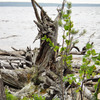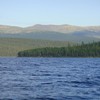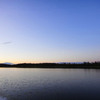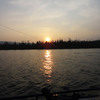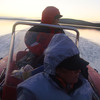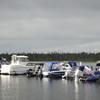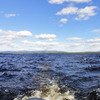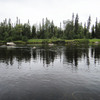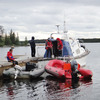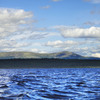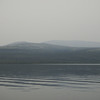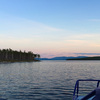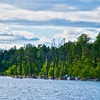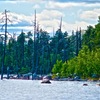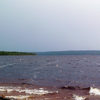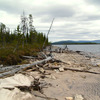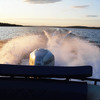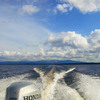Upper-Tuloma HEP
The Upper-Tuloma HEP (Murmansk region) is known as a unique hydro technical facility, not only because it is the largest hydroelectric plant in the North-West of Russia. There are around 300 such hydroelectric plants, completely located underground. But the Upper-Tuloma HEP has its own specifics, which are not met at other underground HEPs.
The plant was constructed by Finnish experts in 1961-1966. In 1961, at the head of the Tuloma River, the Finnish company, “Imatra-Voima”, started the construction of a 228MW HEP, near the ancient settlement of Padun. This was a convenient location – there was a vast rapid at this spot: in an area of 2.5 km the depth increased by 28 meters.
The client company for the Upper-Tuloma HEP was “Tulomgesstroi” and it was jointly designed by “Lengiroproekt” institute. The equipment was installed by the Soviet engineers.
The first turbine was launched in 1964, whereas the overall HEP was commissioned on 27 October 1965. The new plant and the Lower-Tuloma HEP, built three decades earlier, became parts of a unified cascade.
The Upper-Tuloma HEP was situated inside a huge rock, which was drilled by Finnish engineers, using explosives and other equipment. The machine room was located 50 meters deep inside the rock. Only the administrative building is visible on the surface, from which a lift is used to go down to the machine room, water inlet and open type distribution device.
The 30 meter high dam was built right in front of the river rapid and the water to the turbines flows through the tunnels drilled in the rock. Consequently the water falls on the blades of the turbines from a height of 58.5 meters. Approximately 4 cubic kilometres of soil and 745 thousand cubic meters of rock were used in the erection of the HEP.
It was possible to avoid all these ingenious implementation, used to create the necessary hydraulic pressure, but in that case the area of the Upper-Tuloma reservoir (745 km2) would had significantly increased, flooding all of the settlements in the vicinity. In the given case the builders would have had to invest huge amounts of money into the erection of the dam and land moving works. But in the current case the construction of such a powerful HEP cost significantly less (70 million roubles as per the rates of 1961), whereas the plant constructed in such manner is lot more dependable and safe.
When it was built, the plant became the most powerful Hep in the Soviet Union. The accumulated experience was later used for the construction of the Aswan Dam in the then friendly Egypt.
The Upper-Tuloma HEP still looks pretty new. This plant was initially built as a very attractive facility, therefore the workers at the HEP try to maintain it this way. The Finns, who built this HEP, still take pride in being part of this grand project.
One more particularity of the Upper-Tuloma HEP is that it can function in a wide range of capacity, due to functioning with rotary-blade hydro turbines, which can be regulated or adjusted. The fact that the plant is maintained by less than 40 people says a lot about the use of advanced technologies and knowhow.
The margins of deviation in this gigantic facility are in tenths and even hundredths of a millimetre. The turbine vibration rate is just 40 microns, whereas the shaft vibration is just 0.2 millimetres. This is due to the minute tuning of the shafts angle. The turbine’s rotor weighs at 312 tons.
By the way the calculations did have an error. They engineers designed a 1960 meter long fish gate in the rock (tunnel) with an underground fish ladder. However, due to reasons unknown the salmon did not adopt the route. As a result this facility stood idle for many years and subsequently it was closed from both ends with gates and currently it houses the fish breeding factory (silver trout). The Upper-Tuloma fish breeding factory is unique in that it is located 70m below the surface.
Recently the Finnish experts proposed to build a bypass fish gate, bypassing the HEP, in the vicinity of the Upper-Tuloma HEP. Our northern neighbours are ready to invest huge amounts of money in the given construction: about 450 thousand Euros in design and preparation and more than 3 million Euros in the actual construction of the fish gate.
The initial capacity of the Upper-Tuloma HEP was set at 228MW. But later it was discovered that its turbines could generate more. All the generators and other equipment were modernized keeping the given fact in mind. Consequently the plant’s generation capacity was increased by 40MW without adding any new turbines or machines.
Till 1975 the Upper-Tuloma plant played a key role in the regulation of frequency in the Kola power system. The role of the Upper-Tuloma HEP was changed after the inclusion of “Kolenergo” in the unified power system of the North-West. Currently it supplies electricity to Karelia and is a standby source for the whole northern electricity supply system.
The plant is now equipped with latest diagnostic equipment, which automatically processes temperature and vibration data. The turbines are equipped with latest polymer parts – bronze-fluoro-plast, which makes it possible to increase the maintenance period up to 11 years.
At the Upper-Tuloma HEP, they conducted research as per the TACIS plan “River Tuloma”, which was designed to identify the possibility of letting the young salmon pass through the turbines at the electric plant. Russian, Finnish, Irish and American scientists took part in this project.

